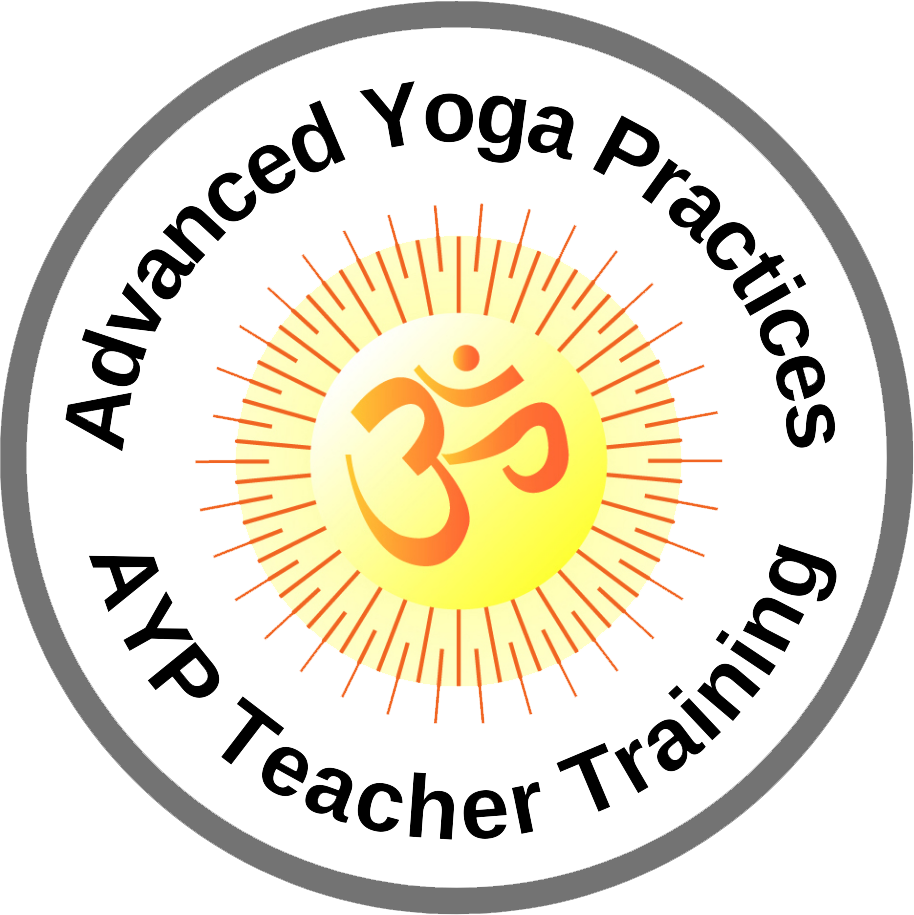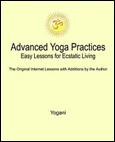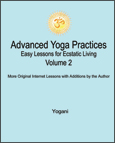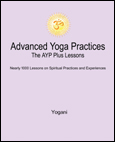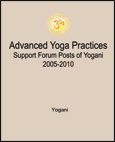|
Public Home | Plus Home | Main Lessons | Tantra Lessons | Public Forum | Plus Forum | Downloads | Books Topic Paths | Search | Training-Retreats | Testimonials | Survey | Interviews | MultiMedia | Contact | Donate |
|
Advanced Yoga Practices Note: For the Original Internet Lessons with additions, see the AYP Easy Lessons Books. For the Expanded and Interactive Internet Lessons, AYP Online Books, Audiobooks and more, see AYP Plus. Lesson 367 - Suggestions for Over-Sensitive Meditators (Audio)
AYP Plus
Additions:
From: Yogani New Visitors: It is recommended you read from the beginning of the archive, as previous lessons are prerequisite to this one. The first lesson is, "Why This Discussion?"
In the previous lesson, we discussed suggestions for "under-sensitive" meditators, focusing on spiritual desire (bhakti), regularity of practice, the finer points of meditation technique, and acceptance of our path within its own parameters, rather than measured against the parameters of others. The evolution of patience and persistence were encouraged, leading to individual self-sufficiency on the path. With that, there can be no stopping a practitioner from going all the way. The same can be said for those who may be "over-sensitive" to deep meditation. Certainly, all of the points discussed in the lesson on under-sensitivity also apply to the over-sensitive meditator, and to everyone. But for the over-sensitive meditator, it has become clear over the past few years that additional measures beyond "standard operating procedure" are needed. Over-Sensitivity to Deep Meditation vs. Premature Kundalini Awakening What is over-sensitivity to deep meditation? As with under-sensitive meditators, while it is difficult to know the causes of over-sensitivity (unfathomable karma), we can certainly notice the symptoms, and systematically apply means leading to a more effective and balanced practice. The symptoms of over-sensitivity to deep meditation can be summed up as, "use of mantra resulting quickly in too much energy flowing." When too much energy is flowing through our inner matrix of obstructions, the result is "excessive friction." We have also referred to this as "excessive purification," which is not to imply that it is a sustainable approach to purification and opening. There is only so much purification our nervous system can tolerate in any given period of time. So we are obliged to find ways to regulate the process. It is the same result that can occur if someone of normal sensitivity to deep meditation gets up from a sitting without resting first, or deliberately meditates for much longer than usual (note: inadvertently going over on time rarely creates a problem). The difference is that an over-sensitive meditator will have symptoms during and/or after practice, when meditating very little, even with a good rest at the end. This can mean strong emotions, irritability, physical discomfort, movements, rash, headaches, and so on. If these look like classic kundalini awakening symptoms, it may be so, with one distinction while a premature kundalini awakening may tend to persist without additional stimulation, the symptoms of an over-sensitive meditator are quickly caused by mantra use, and will normally die down within a reasonable period of time after a meditation session. Those with a premature kundalini awakening often find relief by taking up deep meditation and/or spinal breathing pranayama, while those who are over-sensitive to deep meditation may have little in the way of previous kundalini symptoms, and must self-pace their meditation practice to avoid them. Over-sensitive meditators may not find stabilizing help from spinal breathing pranayama either. So we should make a distinction between a premature kundalini awakening, most which come from outside the AYP system, versus an inherent over-sensitivity to deep meditation with mantra which may or may not be heralded by prior kundalini symptoms. Those who come to AYP with a premature kundalini awakening are advised to try deep meditation and/or spinal breathing pranayama according to the lessons, plus additional measures that are available (see Lesson 69), and see how it goes. Many arriving at AYP with a premature kundalini awakening have found balance and good progress by taking this route. Those who find themselves sensitive to deep meditation, with or without a premature kundalini awakening, are advised to read on here. Applying the Standard Methods and Developing the Metrics Before we get into alternative approaches to meditation practice, we should review the standard methods for handling symptoms of excessive energy flow and purification occurring during or after deep meditation with the base mantra. Even if we are over-sensitive to deep meditation with the base mantra, we can use it as a baseline from which we can move in exploring alternatives for developing a stable and effective practice. This does not mean we should engage in a meditation practice that is uncomfortable and destabilizing for us every time we sit to do it. Beyond the normal emotional and physical ups and downs that may occur during deep meditation, which can be handled with the energy/body awareness procedure in Lesson 15, we should be sure to be taking enough rest before getting up after practice. Lying down for 5-10 minutes is good if we are prone to irritability during or after deep meditation. We should also be active during the day, and make sure to get regular exercise. Mental and physical activity play key roles in stabilizing the inner silence we are cultivating during our twice-daily deep meditation sessions. If there is discomfort every time we sit to meditate, we may be over-sensitive. In that case, we can scale back our practice time as much as necessary to reduce our symptoms to a comfortable level. In cases of extreme sensitivity, this could lead to very short meditation sessions even only a few minutes per sitting. If we are consistently encountering uncomfortable symptoms after only 5 minutes of deep meditation, we can be sure that we are over-sensitive. Anything less than 10 minutes per sitting with ongoing discomfort can be assumed to be over-sensitive. Ironically, over-sensitive meditators often have very strong bhakti (spiritual desire), so it can be frustrating to have to scale back meditation time so much. Ultimately, it will be our bhakti that leads us persistently toward a more balanced approach, enabling us to progress with comfort, and even ecstatic bliss! If we have gone beyond learning deep meditation and are doing spinal breathing pranayama and additional practices without noticeable stabilizing effects, then we should eliminate these until we have found a stable meditation practice. This applies to any other practices we may be doing from any source, with the possible exception of a light set of asanas (postures) for limbering up before sitting. If not doing these already, do not add asanas (or anything) if symptoms of over-sensitivity to meditation are occurring. First things first. If our goal is to find a stable meditation practice, then everything else has to take a back seat until we have found a stable routine from which we can later begin to explore other things. In most cases, it is wise to work on meditation first, as it will deliver the abiding inner silence that will enable us to proceed with everything else on our spiritual path. By developing clear "metrics" on what it takes to engage in deep meditation with the base mantra without excessive discomfort, we will establish whether or not we are over-sensitive. If we are self-pacing back to a few minutes per session, we will know it is time to consider alternatives in our meditation practice. We can continue to self-pace with whatever alternatives we try, with the goal of settling in with an approach that enables us to meditate comfortably for 10-20 minutes twice-daily. How we feel in daily activity will be the primary measure of our practice. Once we have established a stable meditation routine, we can draw with confidence on the many additional tools available for enhancing our progress on the spiritual path. One step at a time. Fast Transcending and Modifying the Mantra In discussing the under-sensitive meditator in the previous lesson, we mentioned that inner obstructions tend to be "densely packed," thereby slowing down the flow of awareness inward to more silent levels of the mind. In the over-sensitive meditator, the situation seems to be just the opposite, with inner obstructions being "loosely packed," and awareness going inward quickly. We could also call this "fast transcending." It is a two-way street. No sooner does the over-sensitive meditator quickly go in with the mantra, than the awareness comes quickly out again, bringing excessive purification and opening with it. So, while the over-sensitive meditator may have experiences of bliss, ecstasy and rapidly rising bhakti (spiritual desire), there is also the experience of excessive purification. Then self-pacing may be necessary to the point where meditation time becomes very short. A possible way around this situation is to modify the mantra to facilitate "slower transcending." We cannot suddenly change the nature of the matrix of obstructions in the nervous system we are dealing with. But we can change the vehicle we are using to traverse it, going from the surface of the mind to its silent depths, and back again. There has been some research done in the AYP community on the third enhancement to the I AM mantra, which is the longest mantra we have in the AYP system. The additional syllables reduce the speed with which awareness moves to more silent levels of the mind. In doing so, a longer mantra creates a wider sweep on the way in and also on the way out. It is less prone to "falling through the cracks" between the loosely packed inner obstructions and thoughts of an over-sensitive meditator. While working to stabilize our meditation routine, it is suggested to discontinue spinal breathing pranayama and any other energy stimulating practices or activities we may be engaged in. For those over-sensitive meditators who would like to try slowing down the rate of transcendence, the third enhancement of the AYP mantra is suggested. See Lesson 188 and Lesson 369. This is not a recommendation for everyone to begin skipping through the mantra enhancements willy-nilly. The discussion here is focused on the very specific situation of over-sensitivity to deep meditation. Everyone else will do well to consider taking on the mantra enhancements in order, as instructed in the lessons. Taking on a mantra enhancement slows down the inward and outward flow of awareness in the mind during the procedure of deep meditation. If we are premature in taking on a mantra enhancement, it can feel like we have hit a brick wall, with awareness staying much on the surface of the mind. This is normal, and if we are shifting the gear to a longer mantra at the right time for us, the awareness will go in more slowly through a wider swath of the mind and nervous system. And likewise coming out. For the over-sensitive meditator, jumping to the third enhancement will have the immediate effect of slowing down transcending and can bring some relief on excessive purification symptoms. It may be possible to increase meditation time from the few self-paced minutes we may be doing to 10 minutes or more without immediate discomfort. However, what we have found is that the benefits of using a longer mantra may be short-lived in some over-sensitive meditators. Once we become acclimated to the longer mantra in daily practice over weeks or months, and are going in with it more easily, some of the symptoms of excessive purification may begin to return. Then we are back to self-pacing our meditation time downward again, perhaps to a duration that is unsatisfactory for our level of bhakti. But the long mantra is worth a try for those who are inclined to stay with mantra meditation. No harm can come from it if we are engaged in prudent self-pacing. It can work for some as a long term meditation practice. For others, the long mantra will not solve the over-sensitivity issue, and may instead be a stepping-stone to an approach that does not use a mantra at all. Now let's take a look at that. Note: For more on use of the third mantra enhancement by sensitive meditators, and moving to breath meditation instead, see Lesson 404. Replacing the Mantra with Breath as the Object of Meditation True meditation always involves the use of an object, and systematically refining our awareness of that object in the mind. In AYP the object we use is a mantra (actually, a progressive system of mantras), which has been found to be highly effective for cultivating abiding inner silence in the nervous system. For those who are over-sensitive to mantra meditation, no matter how it is approached, it is suggested to use an object for meditation other than a mantra. There are certainly alternative ways to cultivate abiding inner silence in the nervous system. An ancient and reliable method of meditation used widely in the Buddhist system, and elsewhere, involves using the breath as object, rather than mantra. We can meditate using our breath in the same way we meditate with mantra. The procedure is the same. Starting out, we sit with eyes closed and easily bring our attention to our breath. When we notice that our attention is no longer on our breath, we easily bring it back to the breath. If our attention and the breath have become refined, we come back to the breath at that refined level, just the way we would bring our attention back to a refined level of the mantra if that is where we are when we notice we are off the object of our meditation. And just as with mantra meditation, in breath meditation there can be thoughts or no thoughts with awareness of breath. We don't try and push thoughts out. We just easily favor the breath, no matter what else may be going on. So, the basic instructions for breath meditation are the same as the instructions for mantra meditation. There are a few differences between mantra meditation and breath meditation though, and we should point those out. Some may ask, what is the object we call breath? Is it the sensation of air moving in the nostrils, in the throat, in the lungs? Is it the rising and falling of the chest? As we begin breath meditation, and get into it, we may find it is one of these, or all of these. That is fine. Whatever we perceive the object of breath to be, that is what it is. It is not necessary to physically locate our awareness of the breath. It may start in one place, and move naturally. We can be comfortable with that, easily favor whatever it is, and we will be refining our awareness, purifying our nervous system, and cultivating abiding inner silence. In time, we will find that our attention will go to a very refined aspect of breath that we could call the "energy impulse" of the breath, without a fixed physical location. It is a lot like a refined mantra, and we can be very deep with it. As we become advanced in our practice, we may find ourselves picking up that refined energy impulse of the breath as soon as we sit to meditate, just the way an advanced mantra meditator will be picking up a refined level of the mantra as soon as the eyes are closed. We can't force any of this refinement to happen. It happens by itself as our method of meditation and the object we are using become baked into our nervous system. This is why regularity of practice is so important twice daily, whether we are using mantra or breath. Breath meditation has been found by over-sensitive meditators to be more gentle than mantra meditation, and much less likely to cause symptoms of excessive purification in the nervous system. Of course, there is no guarantee that it will not, but the chances of an over-sensitive meditator finding a stable practice with breath meditation are much better. When using breath meditation and going deep, as with any effective form of meditation, the breath may naturally suspend briefly from time to time. This is a sign that metabolism is low, that we are in deep silence, and that effective purification is occurring. If, during a breath suspension, we become aware that our attention is not on the breath, we may not find much physical breath or subtle energy impulse of breath to favor. If that is the case, we can just easily be in the stillness we are experiencing in the moment. When we notice the physical breath or the faint energy impulse of breath again, then we can return to that at whatever level of refinement we find ourselves. This is the primary difference between breath meditation and mantra meditation. When breath suspends in mantra meditation, we can still favor the impulse of the mantra. When breath suspends in breath meditation, we just relax in stillness until the impulse of breath returns. This is one of the reasons why breath meditation is milder in its effects, which is just what the over-sensitive meditator needs. We self-pace breath meditation just the way we would mantra meditation, according to our comfort in practice, keeping in mind that all spiritual practices have delayed effects. So we will be wise to start off modestly. If we have found it necessary to self-pace ourselves down to 5 minutes per session with mantra meditation (short or long mantra), we should consider starting there with breath meditation, and increasing our time gradually, a few minutes at a time over multiple sessions. That is if we find that we are stable using breath as our object of meditation. If we get all the way up to 20 minutes per session without any serious disruption, it is suggested to stay at that duration of meditation for at least six months, and perhaps indefinitely. While other systems using breath meditation may involve much longer sittings, an over-sensitivity to meditation may be a good reason to stick with the 20 minute limit. It also gives us the option to consider additional practices in the AYP system, without throwing the overall time commitment to spiritual practices out of balance with the rest of our life. As mentioned earlier, while working to stabilize our meditation routine, it is suggested to discontinue spinal breathing pranayama and any other energy stimulating practices or activities we may be engaged in. And we should not be trying to do more than one kind of meditation while we are stabilizing our practice. Breath meditation is a very good practice that can effectively cultivate a foundation of abiding inner silence, which is the primary prerequisite for undertaking additional practices we may be drawn to in due course on our spiritual path. With regard to moving through the AYP lessons, using breath meditation as our foundation instead of mantra meditation, it can be done. But there are a few caveats we should mention. Since we are using breath meditation to find a balance with an over-sensitivity that has resulted in excessive energy symptoms, we should be mindful of the energy implications in many of the AYP practices, beginning with spinal breathing pranayama. Also, we should be aware that spinal breathing and breath meditation are more similar than spinal breathing and mantra meditation. So we should be well-established with breath meditation before we attempt spinal breathing. These are two different practices, involving two different procedures. In this case, both are working with breath in different ways, so we want to be clear about what we are doing with breath meditation before we attempt to add spinal breathing. And there is the energy aspect, so over-sensitive practitioners are advised to be on alert. The same goes for other energy practices, such as mudras, bandhas, kumbhaka, tantric sexual methods, etc. Those engaged in breath meditation may find a more comfortable path of additional practices leading through samyama, self-inquiry and karma yoga (service), which focus less directly on the cultivation of ecstatic conductivity (internal energy flow), and may be more manageable for practitioners who have inner energy sensitivity already present. These practices naturally expand the expression (movement) of inner silence in our life, and will bring the necessary ecstatic conductivity and radiance along with less risk of energy overloads. Samyama, self-inquiry and karma yoga are also excellent vehicles for surging bhakti, which over-sensitive meditators usually have an abundance of. Whatever additional practices are undertaken, prudent self-pacing is always the watch-word. Step-by-step. One thing at a time. And be sure to stabilize each practice, or level of practice, before moving on. Developing Self-Sufficiency for the Long Term It is hoped that the additional tools discussed above will enable over-sensitive meditators to find a stable routine of meditation for cultivating abiding inner silence. The knowledge being shared here is the product of the trials and errors of many practitioners, and we are very grateful to them. Through their experiences, many have a chance to find a stable meditation practice much sooner. It is expected that more will be learned about meditation sensitivity as we move forward, and additional knowledge will be shared as its potential value to the broad community of practitioners becomes clear. As discussed in Lesson 365, it seems clear that world consciousness is rising, evidenced by the fact that spiritual practices in general are becoming more effective. Twenty minutes of meditation today produces more results than twenty minutes of meditation did 10 years ago. If this is the case, then we can expect the standard distribution (bell curve) of meditation sensitivities to gradually become more skewed toward the over-sensitive side. This means that potentially this lesson will find increasing use by more practitioners as time goes on. We intend to keep a focus on sensitivity issues going forward. It is a moving target, and so too must the tools we are offering be continually adapting to accommodate the changes occurring in world consciousness. The discipline of self-pacing gives us a big "leg up" on this, because we are in a position to test any practice while minimizing the risks of overdoing. As has been the case since the beginning of AYP, the goal here is to provide everyone open access to the tools necessary to become self-sufficient in spiritual practice, and hastening everyone's progress toward enlightenment with comfort and safety. Those who are highly sensitive to meditation have the gift of a nervous system with a high conductivity and radiance of spiritual energy. While the sensitivity that comes with this presents some unique challenges, once the practice routine has been stabilized, wonderful experiences of ecstatic bliss and a great contribution to the rise of world consciousness will be flowing out rapidly. The guru is in you.
Discuss this Lesson in the AYP Plus Support Forum Note: For detailed instructions on deep meditation procedure, see the Deep Meditation book. For detailed instructions on building a balanced practice routine with self-pacing, see the Eight Limbs of Yoga book. Also, for the complete expanded lessons and all the AYP books and audiobooks available online see AYP Plus. |
|
|
|
Join the Mail List:
AYP Retreats
eBooks - PDF, EPUB
FREE eBooks with
SAVE with Bundled
|







